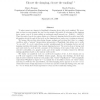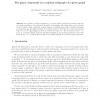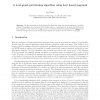WAW
2009
Springer
15 years 5 months ago
2009
Springer
WAW
2009
Springer
15 years 5 months ago
2009
Springer
101
Voted
WAW
2009
Springer
15 years 7 months ago
2009
Springer
We present a deterministic model for on-line social networks based on transitivity and local knowledge in social interactions. In the Iterated Local Transitivity (ILT) model, at ea...
WAW
2009
Springer
15 years 7 months ago
2009
Springer
109
click to vote
WAW
2009
Springer
15 years 7 months ago
2009
Springer
Since the first investigations on web graph compression, it has been clear that the ordering of the nodes of the graph has a fundamental influence on the compression rate (usuall...
120
click to vote
WAW
2009
Springer
15 years 7 months ago
2009
Springer
We study personalized web ranking algorithms based on the existence of document clusterings. Motivated by the topic sensitive page ranking of Haveliwala [19], we develop and imple...
109
click to vote
WAW
2009
Springer
15 years 7 months ago
2009
Springer
We consider a random subgraph Gp of a host graph G formed by retaining each edge of G with probability p. We address the question of determining the critical value p (as a function...
WAW
2009
Springer
15 years 7 months ago
2009
Springer
WAW
2009
Springer
15 years 7 months ago
2009
Springer
The Modularity-Q measure of community structure is known to falsely ascribe community structure to random graphs, at least when it is naively applied. Although Q is motivated by a ...



